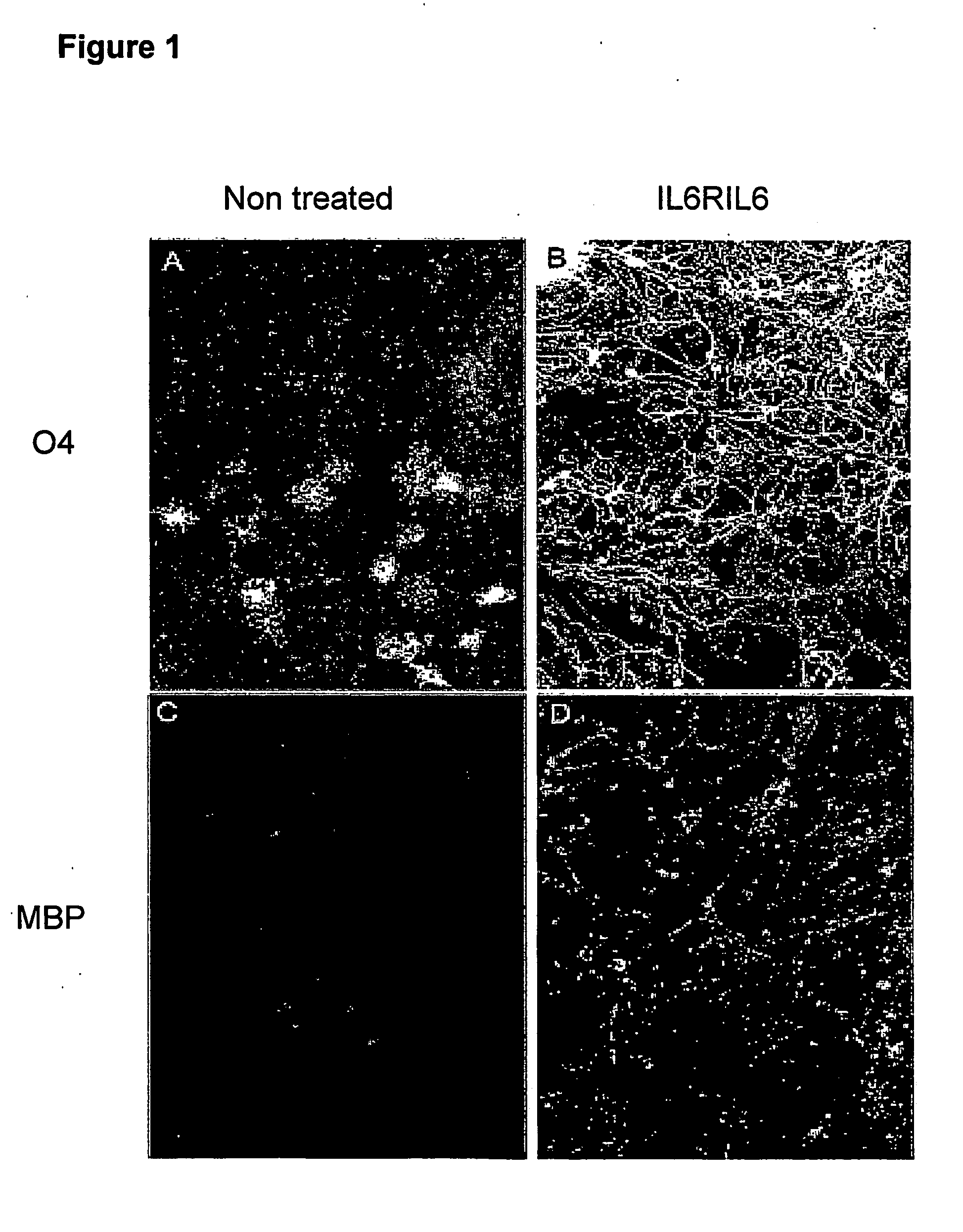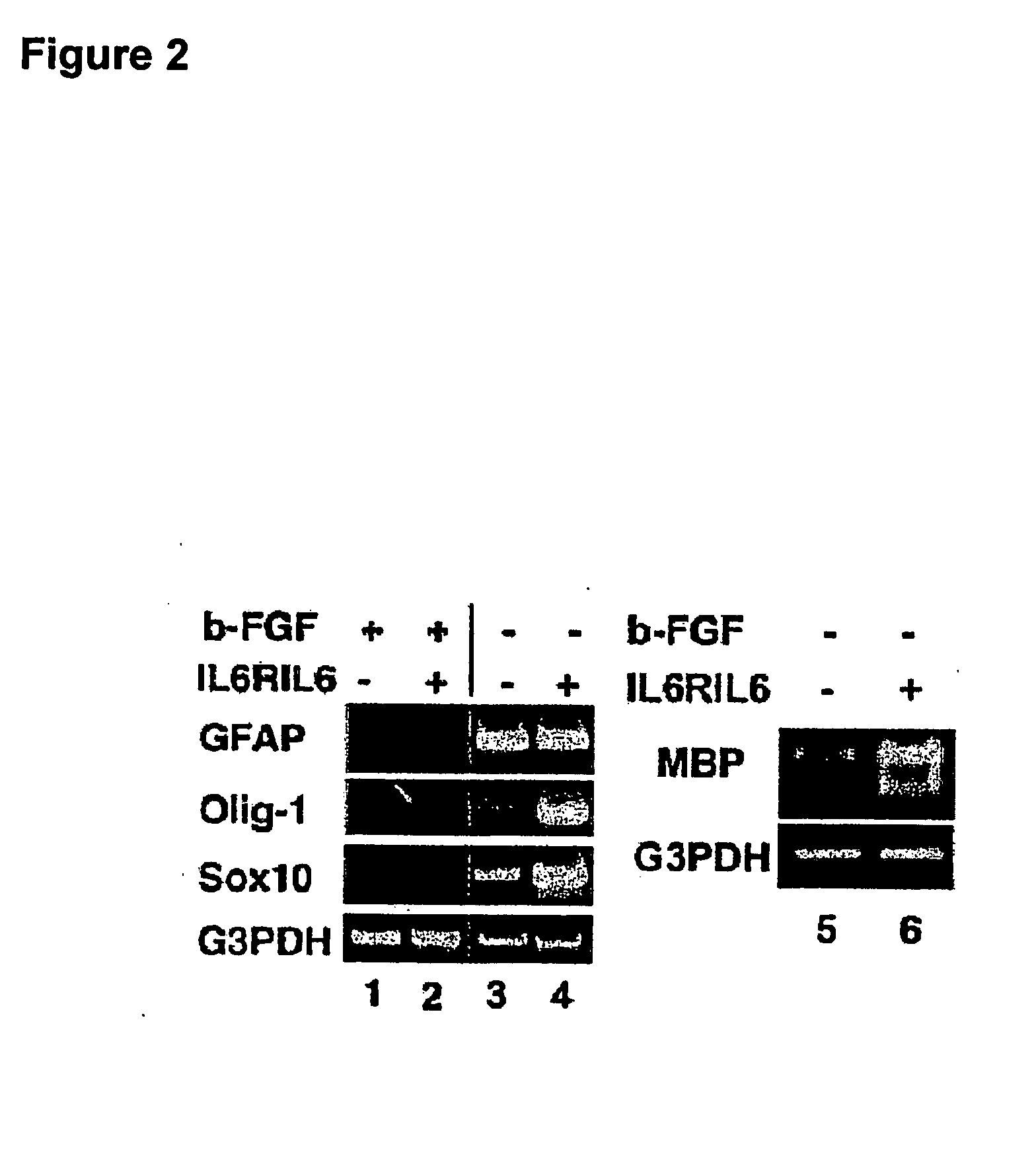Enhancement of oligodendrocyte differrentiation
a technology of oligodendrocytes and differrentiation, applied in the field of neurodegenerative diseases and disorders, can solve the problems of many difficulties, difficult to ascertain, and the cell that could be obtained
- Summary
- Abstract
- Description
- Claims
- Application Information
AI Technical Summary
Benefits of technology
Problems solved by technology
Method used
Image
Examples
example 1
IL6R / IL6 Chimera Enhances the Differentiation of Oligodendrocyte Progenitors Expressing the O4 Sulfatide
[0127] The murine ES cell line Rosa 11 (R11) (Li et al. 2001) was seeded at 0.7×106 cells / 6 cm dish on top of feeder layer of γ-irradiated embryo fibroblasts (see below) in 5 ml of ES medium comprised of Dulbecco's DMEM high glucose (4.5 mg / ml) (Gibco / BRL) with 0.1 mM non-essential amino acids, 2 mM glutamine, 1 mM sodium pyruvate, 0.1 mM β-mercaptoethanol, 100 U / ml penicillin, 0.1 mg / ml streptomycin, 15% fetal calf serum (FCS) and 40 mg / ml leukemia inhibitory factor LIF, and cultured 3 days. All cultures were at 37° C. in 6.5% CO2, with daily replacement of medium. The feeder cells were obtained by trypsinisation of 15.5 day old mouse embryos, cultured at 5×106 cells / 10 cm plate in 10 ml of DMEM high glucose (4.5 mg / ml), 10% newborn calf serum (heat-inactivated at 56° C., 0.5 hour), 2 mM glutamine, 50 U / ml penicillin, 50 μg / ml streptomycin, trypsinized and suspended in 5 ml of s...
example 2
IL6R / IL6 Chimera Enhances the Maturation of Oligodendrocytes to the Myelinating Stage
[0132] The same procedure as in Example 1 was used, except that the cells growing out from neurospheres were stained with monoclonal antibodies against the myelin basic protein MBP (MAB 386, Chemicon). The accumulation of MBP, a structural myelin protein was clearly observed in the oligodendrocyte network of IL6R / IL6 chimera-treated cultures, but not in the corresponding control cultures (Figure lower panels). The gp130 activator, therefore, not only increased the number and density of the ES-cell derived oligodendrocytes but also their maturation toward the myelinating phenotype. This maturation was further denoted in the IL6R / IL6 chimera-treated cultures by the development of flattened myelin-like membrane sheaths that characterize myelinating oligodendrocytes. This was not seen in the untreated cultures.
[0133] The maturation of oligodendrocytes is also characterized by the appearance of the O1 ...
example 3
IL6R / IL6 Chimera Increases the Number of Oligodendrocyte Progenitors in Short Term Dissociated Cell Cultures
[0135] Prolonged maintenance of ES cells on the feeder layer gives rise to cell clumps which are enriched for neural progenitors and can be mechanically isolated (Reubinoff et al. 2001). The clumps form floating neurospheres upon culture in serum-free defined EB medium (conditions described in Example 1). Such spheres, prepared from R11 ES cells, were then digested with 5 mg / ml of collagenase / dispase mixture (Sigma, #C3180, St Louis, Mo.) and the dissociated cells were seeded on poly-D-lysine and fibronectin cover slips at a density of 1.5×104 cells / well in 12 well plates. Culture was in defined differentiation medium as in Example 1, FGF-2 and 5 μg / ml laminin being added for the first 4 days and then removed. At this time, half of the wells were supplemented with IL6R / IL6 chimera, 200 ng / ml, and the cultures continued for 18 days. The fixed cells were stained with the Rip mo...
PUM
 Login to View More
Login to View More Abstract
Description
Claims
Application Information
 Login to View More
Login to View More - R&D
- Intellectual Property
- Life Sciences
- Materials
- Tech Scout
- Unparalleled Data Quality
- Higher Quality Content
- 60% Fewer Hallucinations
Browse by: Latest US Patents, China's latest patents, Technical Efficacy Thesaurus, Application Domain, Technology Topic, Popular Technical Reports.
© 2025 PatSnap. All rights reserved.Legal|Privacy policy|Modern Slavery Act Transparency Statement|Sitemap|About US| Contact US: help@patsnap.com


